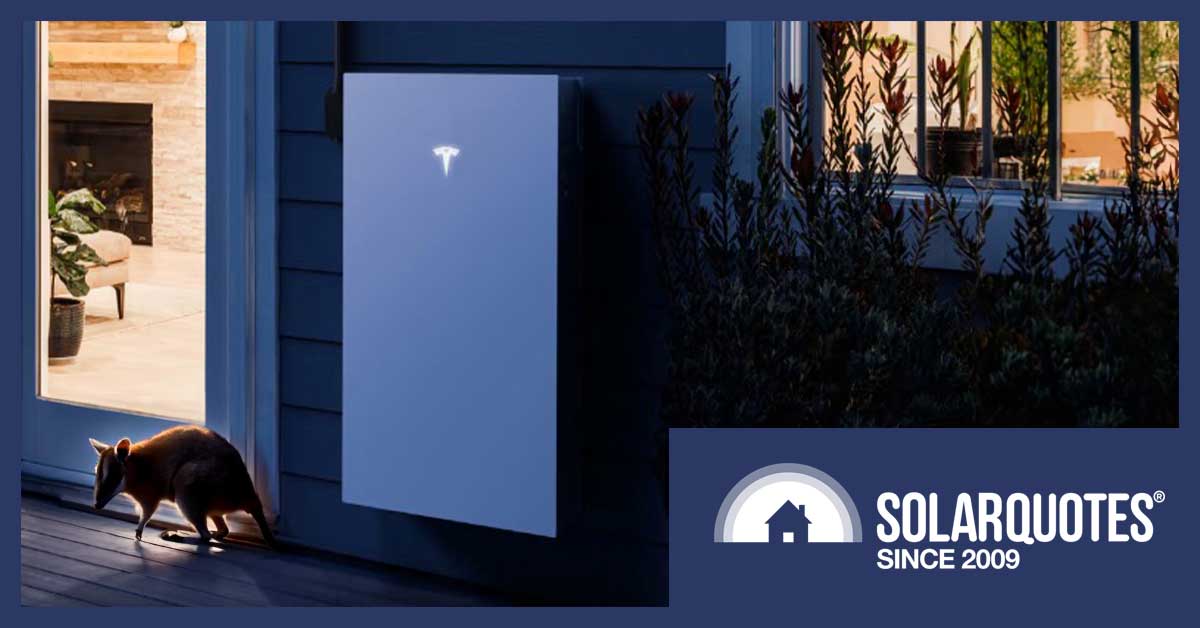
Image: Tesla (possum added). Note: This Powerwall 3 install would not be compliant in Australia. Too close to the windows and requires a fire-rated backsheet because it backs on to a habitable room.
Update: 16 August 2024 –Tesla Australia have launched the Powerwall 3 – read all about the launch here.
Price: $13,600 including Gateway (Battery: $11,900, Gateway $1,700)
That’s $1,500 more than the PW2, but you are getting an integrated hybrid solar inverter configurable as either 5kW or 10kW. Separately that would cost at least $2,000.
The Australian version is confirmed to have 3 MPPTs (not 6 like the US version).
Tesla says the Powerwall 3 will not be compatible with Powerwall 2 installations.
Last week, Tesla officially put the Powerwall 3 up for sale on its US website, and released some previously unknown details about the much anticipated home battery.
Here’s what we know so far about the Powerwall 3 and what we can expect when it goes on sale in Australia – hopefully in the second half of 2024.
Powerwall 3 Price
To be clear: Tesla have not announced Australian pricing yet. But the Tesla US website lists the Powerwall 3 hardware at the same price as the Powerwall 2 was selling for.
This suggests the Powerwall 3’s Australian price could be the same as the PW2’s Australian Price: AU$10,400 (not including installation or Gateway).
Built-in Solar Inverter
Readers may be disappointed that the Powerwall price has not dropped with V3, but in fairness to Tesla, the new Powerwall comes with an inbuilt 10 kW solar inverter:
- with 3 MPPTs
- that takes up to 20 kW of panels – which should be allowed under Australian ‘oversizing’ rules because it can reportedly also deliver 5kW direct to the battery.
A 10kW hybrid Sungrow inverter with similar specs retails for over AU$4,000. Keeping the Powerwall 3 price the same as the PW2 suddenly starts to look like pretty good value.
The Powerwall 3 still needs a AU$1,700 Gateway to handle backup and power sensing.
Here’s Tesla’s schematic of solar panels integrated with a Powerwall 3.
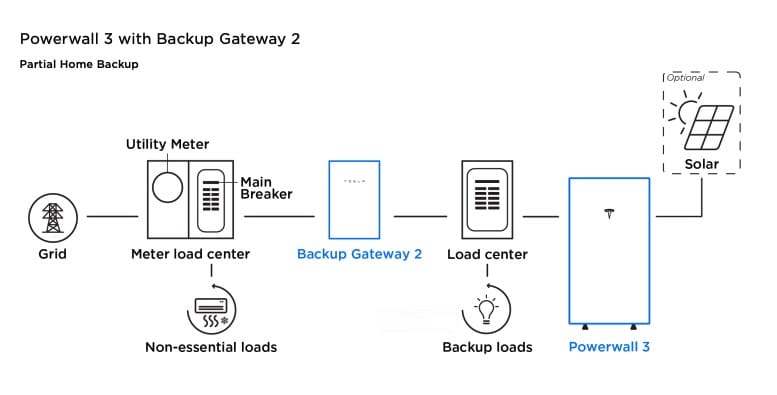
Translation: ‘Load Center’ is American for ‘Switchboard’.
DC Coupled Expansion Units
Update April 11 2024: DC Expansion Units have been confirmed by Tesla
Tesla are marketing the Powerwall 3 with future “DC-coupled battery expansion units”. At least one US installer with Powerwall experience claims these DC expansion packs will be:
“dummy PW3’s. Basically units without the integrated inverter.”
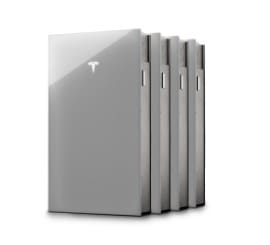
Up to 4 Powerwall 3s can be stacked. Cheaper expansion packs that ship without a solar inverter are rumoured to be coming
If this is correct, this promises expansion packs for thousands of dollars less than the cost of the initial Powerwall 3 – because you are not paying for the solar inverter electronics, and the expansion pack installation should be much quicker.
Yup. DC expansions are ‘dummy’ PW3s. Basically units without the integrated inverter …
— Ernesto Grossmann (@ripple_energy) February 18, 2024
Same Energy, Lots More Power
It’s already been widely reported that the Powerwall 3 stores the same 13.5 kWh of energy as the Powerwall 2, but power output is improved significantly to 10kW continuous (with Anthony predicting this will be usually be throttled to 10 kW to keep within Australian DNSP rules).
Old mate Elon says you can backup most US homes entirely with one Powerwall 3. But while you may not hit a power limit backing up the whole house, big loads will soon drain 13.5 kWh of energy, so I’d still recommend putting stuff like EV chargers, saunas, grow lamps, ovens and large heating/cooling systems on a non-backed up circuit.
Peak Power Rating Is Excellent
One problem many solar batteries have when running without the grid is they struggle with high inrush currents when motors start up, whether that’s an air conditioner or a pool pump. The Powerwall 3 is rated at 185 LRA. Which means it can produce a whopping 185 Amps to get those motors started.
What the hell is LRA?
Locked Rotor Amps (LRA) is a term used to describe the maximum current or amps that an electric motor, like those found in air conditioners or pool pumps, draws when it first starts up. Imagine trying to push a heavy piece of furniture across the room. Initially, you’ll need to put in a lot of effort to get it moving. Similarly, an electric motor needs a big surge of electricity at the start to overcome its initial inertia and start turning. Once the motor is up and running, it settles into using much less power.
Battery Charging Power Is Limited
It’s worth noting that, although the Powerwall 3 can discharge at 10kW, battery charging is limited to 5 kW. But the Powerwall 3 can send 10kW to the home and charge the battery at 5kW at the same time – so it can use 15kW of solar power, as long as the battery is not full.
Backup Switch (US Only)
This won’t be relevant for Australia due to the design of our utility meters, but it’s a good example of Tesla innovation.
In the USA, Tesla have designed a ‘Backup Switch’ that can be installed in a few minutes behind a US grid meter, and means you don’t need to install a Gateway. That saves our American friends a few hundred dollars on hardware (the backup switch costs less than the Gateway) and probably another thousand dollars or so in installation.
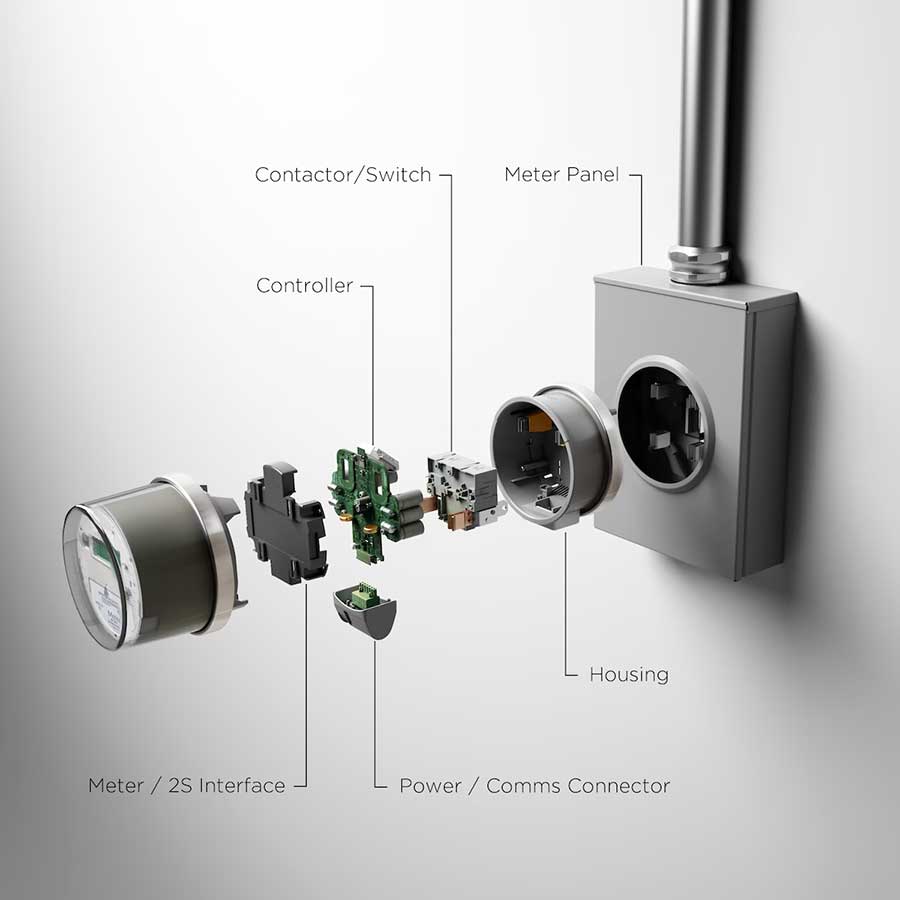
The Tesla Backup Switch. Brilliant enginerring.
Australian Powerwall 3 owners must still use the Tesla Gateway to handle backup duties.
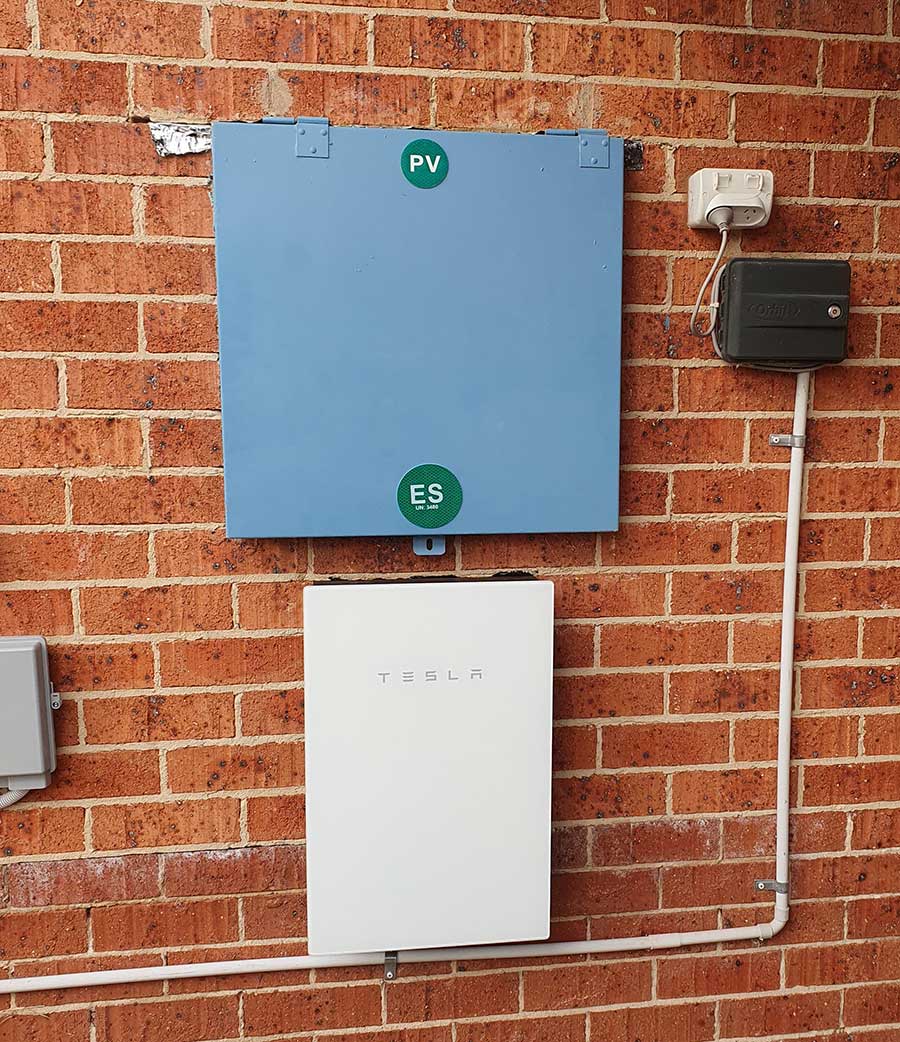
A Tesla Gateway – as used on Powerwall 2s – is also required for Powerwall 3s
Powerwall 3 & Bidirectional Charging
If you install a Powerwall 3, you just need a Tesla Wall Connector EV charger and compatible vehicle, and you can use the kWhs in your car battery as if they were in your Powerwall. It’s a slightly limited form of V2H (Vehicle to Home) that requires no additional hardware. Considering your only option in for V2H in Australia is currently a $10,000 bi-directional inverter that’s very, very cool.
And the good news is: Tesla says Powershare will eventually work with Powerwall 2, Gateway 2 and a Tesla Wall Connector.
The bad news is that the only compatible vehicle right now is the Cybertruck.
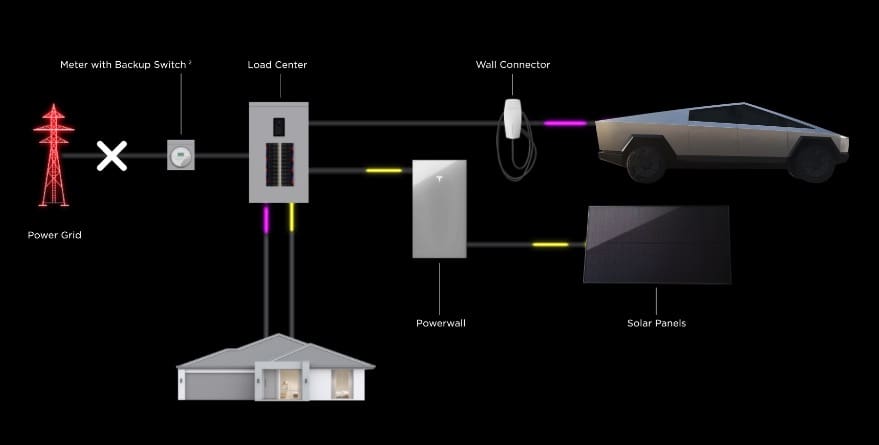
Replace the US-only ‘Backup Switch’ with a Tesla Gateway and this should work in Australia…
Powerwall 3 Retrofits May Be Possible
Update 17 August 2024: Tesla says you can retrofit the PW3 to existing solar via AC-coupling up to 5kW (inverter size).
Tesla’s official stance is that Powerwall 2 will continue to be sold for retrofits to existing solar systems, with Powerwall 3 designed to be installed alongside new solar installs only.
It may be possible to plug an existing solar array into a new Powerwall 3, making your old inverter redundant, but that will depend on the age of your panels and the string configuration. For retrofits to solar inverters over 5kW, it’s probably easier to just add a Powerwall 2 and not dick about with your existing solar.
If you want to expand a Powerwall 2, add a Powerwall 2, don’t try and mix and match PW2 and PW3.
Is The Powerwall 3 LFP?
Update April 11 2024: Tesla have confirmed the Powerwall 3 uses LFP cells
The battery cells in the PW3 have long been rumoured to be cobalt-free LFP chemistry. But there are compelling arguments that they will remain nickel/cobalt based NMC cells. Indeed the Powerwall 3 user manual says:
“This product can expose you to chemicals including cobalt and lithium compounds”.
It’s Typical Tesla Innovation
The Powerwall 3 sticks to the Powerwall 2’s price tag (in the USA, at least) but packs in a 10kW solar inverter and 5 kW battery charger and is ready to handle 20kW of solar panels, offers gutsy peak power, cheaper expansion units, and V2H integration. It’s compelling for anyone wanting a big solar and battery system to power their home and EVs.
Just be warned – I haven’t confirmed any of this with Tesla. Since Elon axed Tesla’s PR department in a hissy fit against ‘the media,’ there’s no one to confirm anything with. So, we’re left hanging until the Powerwall 3 hits Australian shores to see what it’s really made of – and what it will cost in dollarydoos.

 RSS - Posts
RSS - Posts



I have a 10.03 kW Enphase Microinverter system with a Mix of M, S and iQ7 Inverters plus 6 x 1.2 kWh Enphase Batteries.
Is it possible to integrate a Tesla Powerwall into that system to achieve Islanding aka Grid Forming Functionally where the Enphase System during a power outage [Solar and Batteries] together with the Powerwall continue to be available to provide power to cover the Household Load?
Hi Anthony,
I have no experience with that vintage of Enphase gear but theoretically if could be done. There are Enphase/Tesla jobs out there running off grid I believe but Tesla do not support them these days.
You can’t have a 5kW powerwall 2 with more that 5kW of AC coupled solar running off grid, unless the Enphase has some sort of throttle applied to lower it to 5kW.
Try Facebook for the local Enphase enthusiasts but don’t be surprised if installers are shy at doing R&D projects on legacy systems.
While still expensive, I like the the idea of a built in inverter.
I am looking to buy or build in a few years and either way I am looking for a system that doesn’t look as it’s got a wall full of components and wires with extra boxes for fuses etc.
Having said that if I have a shed to stick it all on I really don’t care so much about the clutter just performance.
I read in the forums there was a Tesla youtube video for installers going around (before it was made private). Apparently they are working on 3 phase backup with Powerwall 3. Can you confirm Finn?
https://teslamotorsclub.com/tmc/threads/powerwall-3-roadmap-3-phase-coming.321409/
Hi Aaron,
Seeing as the Americans have almost entirely 110v split phase supplies (peasants) there’s vanishingly little demand for 3 phase stateside. Same reason they rejected type 2 EV charging and invented “NACS” as their own standard. Don’t hold your breath that they’ll make something for us in 3ph.
Yeah, that is true. I know Europe have been asking for a 3 phase Powerwall too. Maybe they mean a software solution. 3 Powerwall 3s using software to tie the phases to 120° apart
Inclusion of an inverter in the package is a game changer in my opinion, removes apx $4k expense of the solar in inverter (and the conversion losses) for a solar + battery install. I do think LFP batteries would have to be part of the spec given its characteristics and their production supply.
How long before Australia gets it, and in what form? Who knows. I suspect we are in for a longer wait.
If you use the weight of the unit from specs sheet as an indicator, it is unlikely to be LFP.
I’m wondering why they wouldn’t use them? Arnt they cheaper, and have better charging characteristics, just don’t deliver as much peak power/
Might just be the increased weight as a transport saving, cheaper or a supply chain issue.
I have 13.3 kW of solar panels and a 10kW grid tied inverter (throttled to 5 kW export because the installers “tricked” me). So far so good. Free electricity and $100+ / month tax free income from my solar exports. I live in Queensland and my local electricity supplier is Ergon Energy (Qld) .
Have been looking to add battery storage to offset night time use and maximise exports to the grid, which alas means ditching my “old” inverter and buying a new hybrid (aka battery ready) inverter.
Sounds like the inverter in the PW3 should save me the cost of the new hybrid inverter. Is this correct ?
Also my local solar installers say that will not allow me to export from battery to the grid if I also export from solar panels to the grid – is this correct ? This is very backwards compared to other countries.
How would Ergon Energy / the grid know where the electricity comes from if the battery and solar panels are all “behind” the inverter ?
Will the PW3 allow me to export excess solar during the day and excess battery during the night ?
The PW3’s 6 MPPTs and maximum of 20kW of solar panels are very interesting. If I could export to the grid from both solar panels and battery, then I will rearrange my existing 13.3 kW of solar panels and add another 6.7 kW to really maximise solar generation all through the day, placing some on sheds that are in sunlight when my house roof is in shade in the early mornings and late afternoons. A good plan ?
I have 3 separate solar systems and a PW2 and no hybrid Inverter
PW2 gateway uses coupling to measure the current in various locations and charges the battery when there is export detected
“ The bad news is, the only compatible vehicle right now is the Cybertruck.”
Will it work with non-teslas that have V2L capabilities?
I very much doubt it.
When the ordered V2L cable for my MG4 turns up, and my off-grid solar install is complete, I figure I’ll be able to plug the V2L output into the generator input on the installation. OK, the MG4 inverter only outputs enough for a fridge/freezer and some lights, but in dire straits, that could save the icecream.
And it doesn’t cost $10k. The cable pulled from the generator should plug into the V2L cable, so zero cost, I figure.
And when the sun reappears, the Victron EV charger is on the wall, awaiting commissioning, perhaps on Monday. With 27 kW of panels, I’m hoping for a full 7 kW EV charging rate, off-grid, for free km and no subsidising of climate destruction. (The MG4 is great, but that 1 kW granny lead is a helluva hobble.)
Shame we won’t be able to install Powerwall 3 in Western Australia at all.
Single phase 5kW inverter limit.
I suspect either Western Power will change that crazy limit, or Tesla will be able to software limit the inverter to 5kW to keep them happy. Otherwise you’re stuck with 5kW solar inverter + Powerwall 2 out west.
Thanks Finn
To the best of my knowledge, Western Power don’t accept software limiting…on the basis that it could be undone I suppose. They go by the CEC listings for each inverter, so Tesla would have to come up with a whole new 5kW just for us in WA. Can’t see that happening…unless they go,’ well we have to do a 10kW for much of Australia as 11kW is too high,’ so why not a 5kW as well’.
The other issue is that we are already awash with other perfectly good 5kW single phase hybrids with batteries.
Would have much preferred an AC Coupled 3 phase 10kW inverter/battery but 3 phase, as said above, is low on the priority list.
Hi Andrew,
There are other networks that accept software limiting if it’s password protected. We’ll just have to make sure your DNSP people get with the program.
We only have one DNSP…Western Power. With no competition, they do as they please and always have.
Some Western Power rule examples…
1. 5kW single phase inverter limit.
2. Enforced export limiting of 1.5kW (not per phase) for >5kW inverters
(also zero FiT)
3. AC Coupled inverter/Battery must not ever be capable of connecting solar panels (e.g. no hybrids AC Coupled) if the existing solar inverter(s) have already reached the inverter limit, (in other words, must be a ‘battery only’ inverter like PW2).
4. 3kW phase imbalance on three phase with the exception of DC/AC Coupled batteries where 5kW imbalance is allowed…
So I wish Tesla luck with getting the monopoly DNSP to negotiate change, as they haven’t done that to date,
Until home storage provides a ROI greater than government bonds and a useful capacity then from a finance perspective is still a poor investment.
13 KWh is still curiouy small considering even the cheapest EVs have many times this, and the cost still means a poorer return than bonds.
So the only benefits are still non financial.
Installed cost needs to fall below $500/KWh to change this.
Hi.
I’ve got 10kw of panels on the roof, two Fronius boxes, a PW2 with gateway. We can export off the panels to the grid (limited to 5kwh), and are usually somewhat self sufficient except for some days in winter (we are one hour north-west of Melbourne).
I’d like to add another battery (we get power outages here and one PW is fine for minimal stuff but I’d like more). Would we need to get another PW2, or could we wait for a PW3, would it marry into the current system?
Haig the PW3 is great if you add more solar (and more solar is always a winner)
For retrofits the PW2 is fine, they’re easy to stack in parallel.
I assume the two would marry up because if it’s one thing Tesla exell at, it’s the app.
Thank you AB. Happy enough to stick with the PW2 but aspects of the tech inside the 3 got me thinking.
Can it be explained why the 3 can only work with new installs? In our case, we could install panels on our granny flat and therefore we have a new ‘install’, but would it talk to the rest of the system and play nice?
And for sure, the Tesla app is a nice bit of kit, I might even say it’s addictive!
The “only work with a new install” refers to the PW3 being DC coupled not AC coupled. So you can’t (currently) hook it up to the output of an existing inverter (AC coupled). You could replace your existing central inverter with a PW3 or even your microinverters (but that would involve a complete re-wire of the roof so that sounds expensive). Anthony mentions in the article that may change but technically I don’t see how? You would physically need a separate AC to DC transformer on board. The PW3 may have one for battery charging but at the most that would be 5kW.
Hey – sorry if this is a basic question – but I am confused about the idea that the Powerall 3 can take 20kw of panels and “although the Powerwall 3 can discharge at 11.5kW, battery charging is limited to 5 kW.”
So does that mean you can install 20kw of solar panels, but only 5kw of that will actually be used to charge the battery? The other 15kw is wasted?
Hi Andrew,
It’s more that 20kW of panels might only deliver 25% of their name plate capacity at 9am, or 3pm, or when it’s overcast perhaps… so all of that capacity is available to charge the battery at an expensive time of day. Excess solar production is a feature, not a bug.
Cool – so does the electricity from the solar panels need to go through the battery 5kV inverter first?
Like in the middle of the day, if the panels are producing 20kV and the inverter is only able to process 5kV – if the house is using 6kV, does the remaining 1kV come from mains supply?
Hi Andrew,
kV is kilovolts… just be aware that solar isn’t going to produce 20,000 volts.
I don’t have an exact idea on the internal topology but the PW3 should charge it’s battery with 5kW of DC directly, with 11kW of inverter capacity available then the house can use 6kW of solar and there will still be 5kW available to export to the grid as well.
As far as I know…
“battery charging is limited to 5 kW”.
What if you had 2x PW3s (2nd expansion module) related to solar charging?
No point having big power on roof when you can only “trickle” charge multiple PWs during a limited solar charge window (9am-3pm).
Hi I have a 3 kw solar system on the old SA power payment of 49c. I also have a solar hot water unit on a high power rate along with other times as now my power plan has been change using set up of different times and charges. Could I use the new Tesla power wall to be power up via grid on the cheaper rate as a storage to be used at a later time out side the cheaper time. I planning to get more solar but will be building later a new house on site.
Hi Mark,
SAPN will kick you off the Pfit scheme if you give them any excuse, and a battery is one of them.
They should offer a trade in scheme where they pay out the potential pfit for a battery install but I wouldn’t hold my breath.
If you’re building a new house then check out someone like Enduro Builders and the ideas around passive solar design.
Hi
Any firm update on timing to Australia of the Powerwall3 and indicative price ?
Thanks
…can we install this bad boy (Tesla Powerwall 3) next to our 10kw non-hybrid Sungrow inverter, on single phase?…it’s 10kw inverter capacity per phase with SAPN but perhaps this might be a loop-hole, to get 33kw of panels & 20+kw of inverter capacity, on single phase? 🤔
SAPN allow 10kW of solar inverter per phase.
They’ll allow 10kW of additional battery inverter (like a Selectronic SpPro)
If you put a hybrid inverter in, it counts toward both allowable totals… so 10kW hybrid is the max capacity.
https://www.solarquotes.com.au/grid-connection/sa/
This week Powerwall 3 is now available in Australia, yay!
That’s a neat trick seeing as it hasn’t shown up on the Clean Energy Council approved inverter or battery lists yet, so it may well have arrived, and it may well be available, but it’s not allowed to be installed onto any grid in Australia until approval is granted.
https://www.cleanenergycouncil.org.au/industry/products/inverters/approved-inverters
Been hoping the price will be cheaper especially considering it is LFP. Yeah inverter is included but still when adding the cost of panels and installation, 2c FiT in WA, extra charges we pay to Synergy and the small capacity of the battery itself (will drain in a jiffy using an aircon in summer, or any energy hungry device)….. there is no financial benefit for me. All I would be doing is paying all my energy bills in advance.